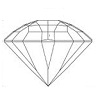16.11: Spodumene
- Page ID
- 4313
\( \newcommand{\vecs}[1]{\overset { \scriptstyle \rightharpoonup} {\mathbf{#1}} } \)
\( \newcommand{\vecd}[1]{\overset{-\!-\!\rightharpoonup}{\vphantom{a}\smash {#1}}} \)
\( \newcommand{\dsum}{\displaystyle\sum\limits} \)
\( \newcommand{\dint}{\displaystyle\int\limits} \)
\( \newcommand{\dlim}{\displaystyle\lim\limits} \)
\( \newcommand{\id}{\mathrm{id}}\) \( \newcommand{\Span}{\mathrm{span}}\)
( \newcommand{\kernel}{\mathrm{null}\,}\) \( \newcommand{\range}{\mathrm{range}\,}\)
\( \newcommand{\RealPart}{\mathrm{Re}}\) \( \newcommand{\ImaginaryPart}{\mathrm{Im}}\)
\( \newcommand{\Argument}{\mathrm{Arg}}\) \( \newcommand{\norm}[1]{\| #1 \|}\)
\( \newcommand{\inner}[2]{\langle #1, #2 \rangle}\)
\( \newcommand{\Span}{\mathrm{span}}\)
\( \newcommand{\id}{\mathrm{id}}\)
\( \newcommand{\Span}{\mathrm{span}}\)
\( \newcommand{\kernel}{\mathrm{null}\,}\)
\( \newcommand{\range}{\mathrm{range}\,}\)
\( \newcommand{\RealPart}{\mathrm{Re}}\)
\( \newcommand{\ImaginaryPart}{\mathrm{Im}}\)
\( \newcommand{\Argument}{\mathrm{Arg}}\)
\( \newcommand{\norm}[1]{\| #1 \|}\)
\( \newcommand{\inner}[2]{\langle #1, #2 \rangle}\)
\( \newcommand{\Span}{\mathrm{span}}\) \( \newcommand{\AA}{\unicode[.8,0]{x212B}}\)
\( \newcommand{\vectorA}[1]{\vec{#1}} % arrow\)
\( \newcommand{\vectorAt}[1]{\vec{\text{#1}}} % arrow\)
\( \newcommand{\vectorB}[1]{\overset { \scriptstyle \rightharpoonup} {\mathbf{#1}} } \)
\( \newcommand{\vectorC}[1]{\textbf{#1}} \)
\( \newcommand{\vectorD}[1]{\overrightarrow{#1}} \)
\( \newcommand{\vectorDt}[1]{\overrightarrow{\text{#1}}} \)
\( \newcommand{\vectE}[1]{\overset{-\!-\!\rightharpoonup}{\vphantom{a}\smash{\mathbf {#1}}}} \)
\( \newcommand{\vecs}[1]{\overset { \scriptstyle \rightharpoonup} {\mathbf{#1}} } \)
\( \newcommand{\vecd}[1]{\overset{-\!-\!\rightharpoonup}{\vphantom{a}\smash {#1}}} \)
\(\newcommand{\avec}{\mathbf a}\) \(\newcommand{\bvec}{\mathbf b}\) \(\newcommand{\cvec}{\mathbf c}\) \(\newcommand{\dvec}{\mathbf d}\) \(\newcommand{\dtil}{\widetilde{\mathbf d}}\) \(\newcommand{\evec}{\mathbf e}\) \(\newcommand{\fvec}{\mathbf f}\) \(\newcommand{\nvec}{\mathbf n}\) \(\newcommand{\pvec}{\mathbf p}\) \(\newcommand{\qvec}{\mathbf q}\) \(\newcommand{\svec}{\mathbf s}\) \(\newcommand{\tvec}{\mathbf t}\) \(\newcommand{\uvec}{\mathbf u}\) \(\newcommand{\vvec}{\mathbf v}\) \(\newcommand{\wvec}{\mathbf w}\) \(\newcommand{\xvec}{\mathbf x}\) \(\newcommand{\yvec}{\mathbf y}\) \(\newcommand{\zvec}{\mathbf z}\) \(\newcommand{\rvec}{\mathbf r}\) \(\newcommand{\mvec}{\mathbf m}\) \(\newcommand{\zerovec}{\mathbf 0}\) \(\newcommand{\onevec}{\mathbf 1}\) \(\newcommand{\real}{\mathbb R}\) \(\newcommand{\twovec}[2]{\left[\begin{array}{r}#1 \\ #2 \end{array}\right]}\) \(\newcommand{\ctwovec}[2]{\left[\begin{array}{c}#1 \\ #2 \end{array}\right]}\) \(\newcommand{\threevec}[3]{\left[\begin{array}{r}#1 \\ #2 \\ #3 \end{array}\right]}\) \(\newcommand{\cthreevec}[3]{\left[\begin{array}{c}#1 \\ #2 \\ #3 \end{array}\right]}\) \(\newcommand{\fourvec}[4]{\left[\begin{array}{r}#1 \\ #2 \\ #3 \\ #4 \end{array}\right]}\) \(\newcommand{\cfourvec}[4]{\left[\begin{array}{c}#1 \\ #2 \\ #3 \\ #4 \end{array}\right]}\) \(\newcommand{\fivevec}[5]{\left[\begin{array}{r}#1 \\ #2 \\ #3 \\ #4 \\ #5 \\ \end{array}\right]}\) \(\newcommand{\cfivevec}[5]{\left[\begin{array}{c}#1 \\ #2 \\ #3 \\ #4 \\ #5 \\ \end{array}\right]}\) \(\newcommand{\mattwo}[4]{\left[\begin{array}{rr}#1 \amp #2 \\ #3 \amp #4 \\ \end{array}\right]}\) \(\newcommand{\laspan}[1]{\text{Span}\{#1\}}\) \(\newcommand{\bcal}{\cal B}\) \(\newcommand{\ccal}{\cal C}\) \(\newcommand{\scal}{\cal S}\) \(\newcommand{\wcal}{\cal W}\) \(\newcommand{\ecal}{\cal E}\) \(\newcommand{\coords}[2]{\left\{#1\right\}_{#2}}\) \(\newcommand{\gray}[1]{\color{gray}{#1}}\) \(\newcommand{\lgray}[1]{\color{lightgray}{#1}}\) \(\newcommand{\rank}{\operatorname{rank}}\) \(\newcommand{\row}{\text{Row}}\) \(\newcommand{\col}{\text{Col}}\) \(\renewcommand{\row}{\text{Row}}\) \(\newcommand{\nul}{\text{Nul}}\) \(\newcommand{\var}{\text{Var}}\) \(\newcommand{\corr}{\text{corr}}\) \(\newcommand{\len}[1]{\left|#1\right|}\) \(\newcommand{\bbar}{\overline{\bvec}}\) \(\newcommand{\bhat}{\widehat{\bvec}}\) \(\newcommand{\bperp}{\bvec^\perp}\) \(\newcommand{\xhat}{\widehat{\xvec}}\) \(\newcommand{\vhat}{\widehat{\vvec}}\) \(\newcommand{\uhat}{\widehat{\uvec}}\) \(\newcommand{\what}{\widehat{\wvec}}\) \(\newcommand{\Sighat}{\widehat{\Sigma}}\) \(\newcommand{\lt}{<}\) \(\newcommand{\gt}{>}\) \(\newcommand{\amp}{&}\) \(\definecolor{fillinmathshade}{gray}{0.9}\)| Spodumene | |
|---|---|
| Chemical composition | LiAl(SiO3)2 |
| Crystal system | Monoclinic |
| Habit | Prismatic, tabular |
| Cleavage | Perfect, prismatic |
| Fracture | Uneven |
| Hardness | 7 |
| Optic nature | Biaxial + |
| Refractive index | 1.66-1.68 |
| Birefringence | 0.015 |
| Dispersion | Low, 0.017 |
| Specific gravity | 3.18 |
| Lustre | Vitreous |
| Pleochroism | Strong |

Figure \(\PageIndex{1}\): Faceted Yellow Hiddenite
Photo courtesy of
Wild Fish Gems
| Spodumene image gallery |
Crystallography
Crystal system: monoclinic.
Habit: flattened and corroded prism with vertical striations, irregular capping reminiscent of Mountain range; sometimes massive. Generally long slender prismatic crystals, often etched.
Chemical composition
Lithium Aluminium Silicate (LiAl(SiO3)2).
Generally there is little Na present. Fe, Ca may replace Li; Cr may be present (Hiddenite green)
Diagnostics
Color and varieties
Hiddenite: yellow green to emerald green (due to Cr).
Kunzite: clear lilac, pink, violetish, purplish (due to Mn).
Other (Spodumene): Yellow, colourless, gray, blue (yellows due to Fe).
Magnification
Complex three phase inclusions characteristic of of spodumene; cleavages; growth tubes; needle like etch tubes; twin planes; crystals.
Luminescence
Very strong fluorescence: golden pink to orange under LWUV and weaker under SWUV.
Sometimes phosphorescent.
Pleochroism
Strong.
There is generally a strong absorption along the c-axis.
Specific gravity
Spodumene sinks in heavy liquid 2.88.
Treatments
- Irradiation (colorless to pink, other colors).
- Heat treatment (green purple or pink to lighter).
Simulants
| Spodumene | |
|---|---|
| Name | Key separations |
| Euclase | Slightly lower S.G., UV fluorescence |
| Sillimanite | Inclusions, generally inert under UV, higher birefringence |
| Tourmaline | S.G. (lower heft), uniaxial character, Inclusions, R.I and D.R. |
| Thulite | Higher S.G., higher R.I. range and UV fluorescence |
| Rose Quartz | Lower S.G, R.I. |
| Natural Spinel | Singly refractive nature, magnification, spectrum |
| Hiddenite | |
|---|---|
| Name | Key separations |
| Emerald | Lower heft (floats in 2.88), uniaxial, R.I, D.R., magnification features |
| Chrysoberyl | Higher S.G. (heft), spectrum, R.I. |
| Diopside | Higher S.G., R.I., spectrum and stronger doubling of Back facet edges or inclusions |
| Kunzite | |
|---|---|
| Name | Key separations |
| Amethyst | Lower S.G. (floats 2.88), UV reaction unlike spodumene, bull's-eye optic figure, R.I. |
| Morganite | Lower S.G. (floats 2.88), uniaxial, R.I., magnification features |
| Topaz | Higher heft, low birefringence and UV reaction unlike spodumene |
| Pink sapphire | Higher heft, R.I higher and lower birefringence |
Occurrence
Geological occurrence: Spodumene occurs in granite pegmatites, sometimes with very great sizes.
Geographical occurrence: Mainly North and South America; Madagascar; Burma; Brazil. USA: N.Carolina (yellowish green)- hiddenite; Connecticut (lilac); CA (Kunzite); Coahulia Mountains (yellow, yellowish green, bluish pink) Madagascar: Kunzite, green, yellowish - Anjanabonoina. Brazil: Paler hiddenite, white spodumene, cat's eye, yellow to pale green, bluish pink Kunzite, yellow and green Burma: Spodumene from upper Mogok stone tract (blue) Afghanistan: Kunzite, yellow, blue and green.
References
- Gems Their Sources, Descriptions and Identification 4th Edition (1990) - Robert Webster (6th ed.)
- Colour Encyclopedia - J.E. Arem ISBN 0412989115


